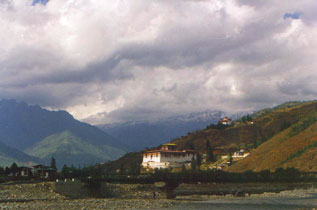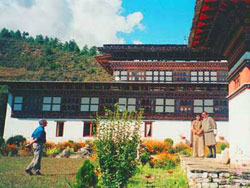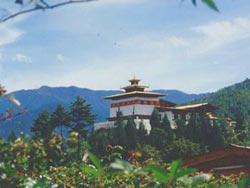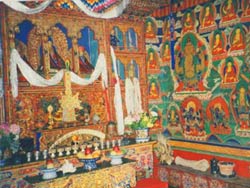|
Travelogues Bhutan: Land of the Peaceful Dragon (Part 2)
|
|||||||||
Paro is the most beautiful of Bhutan's valleys, and also historically the centre of two of the most important trade routes to Tibet. Here the Paro Chu River flows south from its watershed in the Chomolhari range. Above it on a rocky outcrop of the steep hillside stands the Paro Dzong, at an altitude of just over 7000 feet. On the hill above the Dzong stands an ancient watch tower which has been converted into the National Museum of Bhutan since 1967. It is circular in structure and makes for interesting viewing as one spirals downwards in an easy gradient and the air gets cooler and cooler. This museum houses all the precious artefacts the country has to display and one can feel the distinct ethnic culture of the people going back several centuries. |
More on Bhutan • Overview • Places to Visit • FAQ
Travelogues
Photo Gallery | ||||||||
 This was my second visit to this valley, as I felt instinctively drawn to
its many ancient monasteries. It wasn't till much later that I discovered that my special attraction was Taktshang Monastery, called the Tiger's Nest, situated on the ledge of a precipice and fairly inaccessible. It is a wonder of architectural design and concept.
This was my second visit to this valley, as I felt instinctively drawn to
its many ancient monasteries. It wasn't till much later that I discovered that my special attraction was Taktshang Monastery, called the Tiger's Nest, situated on the ledge of a precipice and fairly inaccessible. It is a wonder of architectural design and concept.
Taktshang Monastery is one of the most impressive examples of religious architecture in Bhutan, mainly because of its spectacular location on a ledge with a sheer drop of 1200 m below. Taktshang, or ' Tigers Den', consists of a number of temple buildings of which the "tpelphu" is the main one. It is believed that in the second half of the 8th century, Guru Rimpoche (Padmasambhave) travelled to this place in the last of eight forms, "Dorje Drolo" on the back of a flying tigress. After his arrival he meditated in a cave. This actual cave is the most sacred place of Taktshang around which the lakhangs or temple buildings are arranged. The Tibetan poet-saint Milarepa (1040 -1123) visited the place and composed one of his songs after having spent three months in meditation in this cave. The monastery was built in this sacred place in 1692 by Paro Penlop. Legend has it that there was not enough support during the construction of the foundation, until some fairies came cutting their longhair to serve as a support for the building. In 1950 a fire destroyed six surrounding temples that were repaired in 1957. In 1999, another fire destroyed the entire monastery except for the statue in the main chalet. Reconstruction work has been going on and is almost completed. Tourists need a special pass to go inside the main building. There is a canteen just opposite the complex on another ridge where people usually reach. There is an easy pathway reaching the top of this canteen from where the view is spectacular and this was the spot we aimed to go. However, not having planned the venture properly, we were able to go only three quarters of the way from where we turned back. My hearts desire, Taktshang, will have to await another attempt and till then I'll keep dreaming of the Guru with his Jade Green vase, emitting incense wafting in the breeze which may take me to different heights of consciousness if He so blesses. A few miles to the north, overlooking the Paro Chu, is the Kyichu Lakhang, one of Bhutan's two oldest and most sacred monasteries, dating from the introduction of Buddhism in the 8th century. (The other is the Jampa Lhakhang in Bumthang.) There have been additions to it; the central temple was erected in 1830 and a golden roof added to the monastery itself. A new extension was built by the present Queen Mother. It is said that some of the relics here are originals from Tibet dating back to the 8th century. Here a Lama or Buddhist monk did special Tapasya for many years standing on one foot. His footprint became embedded in the floor and this solitary footprint can still be seen. Though we did not go to Kyichu on this trip, we had the good fortune to have had a thorough visit there in 1999. Paro never unveils her trophies all in one go and those interested have to make many trips to see, imbibe and understand the glory of the many Lakhangs and monasteries that are situated in that valley.
This Dzong was abandoned after being gutted by fire in 1950 but the ruins can still be seen attracts tourists for the intricate underground layouts. The Gangtey Palace Hotel built by Kazi Ugyen Dorji and Raja S.T. Dorji, is a beautifully old fashioned Palace now converted and used as a hotel run by the family members themselves i.e. Mr. And Mrs T.S. Dorji. Mr T.S. Dorji is the son of Raja S.T.Dorji. This building overlooks the Paro Chu and has an imposing location being built upon a hillock. It is typically Bhutanese and the architecture blends with the rest of the old buildings in the valley. There is an open courtyard in the centre with a central stone building in the middle and the rooms are situated both in the inner courtyard and along the outer wall.  The hotel has
all modern amenities and caters to Western Tourists who usually pre-book in groups or separately from their home countries. The rooms are well furnished with running hot water, the dining hall is large and spacious and the lounge cum bar is unique in design and décor. It is mainly circular with large bay windows with overlook the valley and the upholstery smacks of old ethnic material a and design The service is hands on, and reminiscent of the cosy lodges in the west where everybody gathers together in the evenings exchanging pleasantries and personal experiences and making friends. It has a jolly ambience which is warm and friendly.
The hotel has
all modern amenities and caters to Western Tourists who usually pre-book in groups or separately from their home countries. The rooms are well furnished with running hot water, the dining hall is large and spacious and the lounge cum bar is unique in design and décor. It is mainly circular with large bay windows with overlook the valley and the upholstery smacks of old ethnic material a and design The service is hands on, and reminiscent of the cosy lodges in the west where everybody gathers together in the evenings exchanging pleasantries and personal experiences and making friends. It has a jolly ambience which is warm and friendly. Within the hotel itself there is a shrine room right on top. The original temple of the Palace has been kept intact and there is also a small temple outside the hotel within the main grounds, which dates back many centuries. All in all it is truly a novel experience, where one imbibes a great flavour of Bhutan and its culture along with the magnificent scenery, which can be compared to Switzerland, Canada or South of Germany.
While we were there, we were lucky enough to attend a grand spiritual event. It was being conducted by the Rimpoche. The ceremony was for 21 days and people from all over Bhutan converged to Paro for this blessing. It was a gathering of thousands of Buddhists who had braved the distance, the cold, and all the inconveniences. Only once in his career as the Je Khempo is he allowed to have such a gathering and ceremony. There are three chief aspects to the ceremonies: Wang or Blessing, Ling or Empowerment/Initiation and Tril or Cleansing. The monks read the entire scriptures through without a break and others perform 'pujas'. It is to promote peace and community welfare. It is also a blessing to the senior monks that they may become lamas in their next incarnation. Hearing the scriptures recited is believed to prevent individuals from being born as an animal in the next birth. Amongst such a gathering I was the only 'foreigner' and was lucky enough to get access to the Je Khempo. I gave him a white silk scarf according to custom, which he blessed and returned to me. I was able to do 'pranaam' which is considered auspicious by the Bhutanese. What is it that gives one an inner thrill to come face to face with a great being? Is it his spiritual attainment or the fact that he, above all, is in a position to bestow blessings. Perhaps it's the inner conviction that such a person has some link with the Almighty which has led him to occupy the exalted position of the spiritual head of the country. There is no doubt about the fact that when you are on a "path" - the least frequented one - the inward journey so to speak - then you get to meet 'special' people, who would otherwise never come your way; a meeting pre-ordained by destiny.
|
|||||||||
Editor: Romola Butalia (c) India Travelogue. All rights reserved. |
|||||||||

 In Tibet a fierce battle between Kargyupa and Nyingmapa and Sakyapa Sects had
been raging. The Mongols under Gushri Khan had established their authority over Tibet and started vigorous persecutions against the Red Cap Sect and followers of Bonism. Gushri Khan then sent a force to invade Bhutan where people under Ngawang Namgyal were the followers of the Red Cap Sect. A large army of Mongols and Tibetans in 1643 invaded Bhutan. Namgyal met the combined invading force near Kawang Dzong. In a fierce battle, the Tibetans and Mongols were utterly routed in the dense jungle. This defeat shattered the myth of an invincible Mongol army and in the future, the Mongols were unwilling to fight in the humid southern region.
In Tibet a fierce battle between Kargyupa and Nyingmapa and Sakyapa Sects had
been raging. The Mongols under Gushri Khan had established their authority over Tibet and started vigorous persecutions against the Red Cap Sect and followers of Bonism. Gushri Khan then sent a force to invade Bhutan where people under Ngawang Namgyal were the followers of the Red Cap Sect. A large army of Mongols and Tibetans in 1643 invaded Bhutan. Namgyal met the combined invading force near Kawang Dzong. In a fierce battle, the Tibetans and Mongols were utterly routed in the dense jungle. This defeat shattered the myth of an invincible Mongol army and in the future, the Mongols were unwilling to fight in the humid southern region. The architecture is typically Bhutanese. The traditional colours of all
buildings in the country are red and white with floral patterns on
the trusses jutting out. The walls are made of a mixture of sand and clay bricks, the foundation is of stone, and wooden beams are skilfully cut to fit each other most dexterously. The traditional Bhutanese architecture has no nails and no iron bars are used. The building is thick and solid with high walls. Inside there is a large square, in the centre of which is a tower several storeys high. Though imposing, it harmonises with the landscape. Apart from sight seeing one can meditate here, go trekking, climbing, camping, fishing etc.
The architecture is typically Bhutanese. The traditional colours of all
buildings in the country are red and white with floral patterns on
the trusses jutting out. The walls are made of a mixture of sand and clay bricks, the foundation is of stone, and wooden beams are skilfully cut to fit each other most dexterously. The traditional Bhutanese architecture has no nails and no iron bars are used. The building is thick and solid with high walls. Inside there is a large square, in the centre of which is a tower several storeys high. Though imposing, it harmonises with the landscape. Apart from sight seeing one can meditate here, go trekking, climbing, camping, fishing etc.